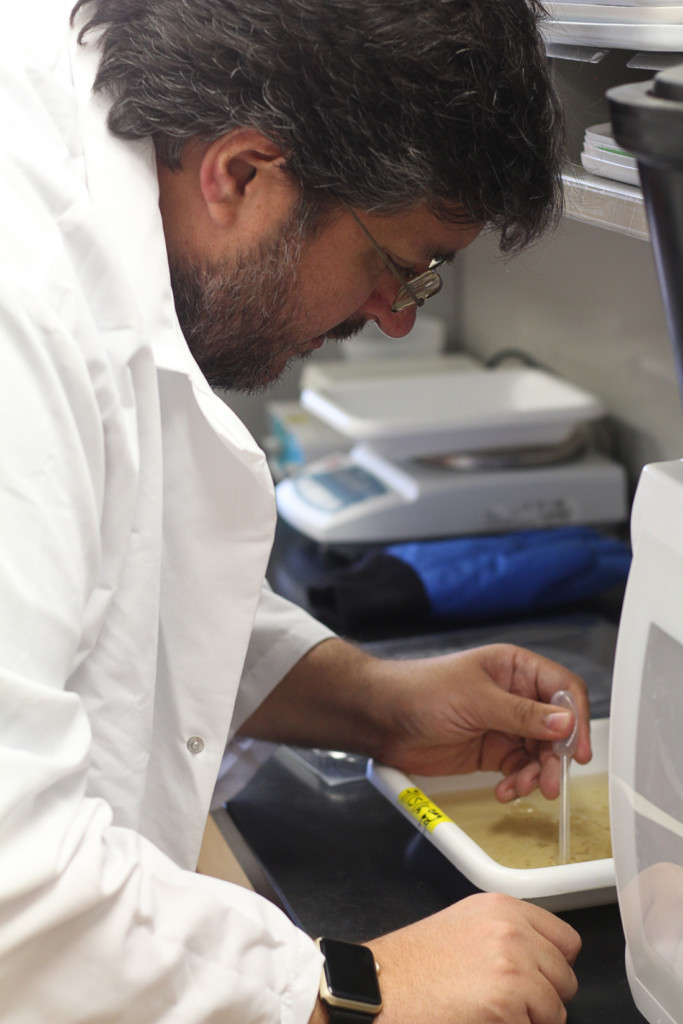
Biology Associate Professor Christopher Vitek extracts mosquito pupae from a dish in the research wing at the Science Building in Edinburg./Gabriel Mata/The Rider
BY Monika Garza | The rider

Within two months, three cases of travel-related Zika virus have been reported in Cameron County.
In February, the World Health Organization declared Zika a public health international emergency.
People have contracted the virus through the bite of an infected mosquito and, in some cases, sexual transmission.
Last Tuesday, the Cameron County Health Department confirmed another travel-related case of the Zika virus.
A 52-year-old woman in Los Fresnos tested positive after traveling to Veracruz, Mexico, in July.
The woman was tested twice. The first test was negative and for the second test, it took about two months for the Texas Department of State Health Services to confirm the woman had a travel-related Zika case.
Marco Lozano, director of Health Emergency Response at the Cameron County Department of Health and Human Services, said that due to the expansion of case definition the department launched this month, more cases are being classified.
“The criteria for testing have expanded, allowing us to test more individuals that may have been exposed or infected with the Zika virus disease,” Lozano said. “The more people we test, the more people we’ll find that have contracted the virus.”
On Sept. 21, a 26-year-old pregnant woman from San Benito tested positive for the Zika virus after traveling in Tamaulipas, Mexico, making it the first confirmed travel-related case in Cameron County.
In an interview with The Rider, John Thomas, a UTRGV biology assistant professor, said the first case was imported.
“That means that the lady acquired Zika outside of the local area and then brought it back here with her when she returned,” Thomas said. “She had traveled to Tamaulipas state a few weeks ago and that is where [health professionals] think she picked it up.”
UTRGV Associate Professor Christopher Vitek said that he is not surprised about the travel-related case reported in San Benito.
“I am not surprised. It’s one of those things where [researchers and health professionals] suspected that there will be cases here,” Vitek said. “It is probably just a matter of time until we have local cases here in South Texas.”
Vitek and Thomas work together at UTRGV and for the state to research approaches to prevent the spread of the Zika virus in the Valley.
“We are trying to identify what mosquito vectors are found in what kind of areas,” Vitek said. “My research primarily focuses on mosquitoes and what influences their behavior, what influences their development, where are they found and what influences their ability to transmit diseases.”
Part of Thomas’ research focuses on what happens once a newborn becomes infected with Zika and the kinds of changes that happen in the architecture of the brain.
“I am doing a lot of my work with animals by infecting pregnant [mice] and then studying the brains of the newborns that they develop,” Thomas said.
In 2015, a 57-year-old woman from Brownsville traveled to Chiapas, Mexico, over the Christmas holidays and contracted the virus, making it the first possible traveled-related case in the Rio Grande Valley.
“This case was first diagnosed as a flavivirus unspecified,” Lozano said. “On Sept.1, there was a reclassification of definition from the Texas Department of State Health Services. Based on the reclassification all cases in 2016 that were flavivirus unspecified were looked at again and this case, in particular, was reclassified from flavivirus unspecified to a probable Zika virus disease.”
Many people infected with Zika will not have any type of symptoms or will have mild symptoms, according to the Centers for Disease Control and Prevention website.
Lozano said there are four major symptoms that they look for: fever, joint pain, rash and conjunctivitis.
“We strongly encourage anybody that shows any symptoms or that has traveled to a country in the Western Hemisphere that may have mosquitoes … [to] go and see your primary physician, especially females that are pregnant and they’re in their first trimester,” he said.





